Churches [1]
"Rock of Ages:" Charlotte's Black Churches Weather Adversity and Retain Strength
by Kathleen McLain
Adapted from the Charlotte Observer, February 8, 1987
The first black church in Charlotte was a wooded grove where the Duke Power building stands in downtown today. As early as 1840, slaves who could slip away gathered under the branches to sing and pray.
AME Zion missionaries organized the loose-knit congregation into Clinton Chapel AME Zion Church [2] in 1864 and began, near the corner of South Mint and Stonewall streets, the most influential black movement in the city's history.
As freed slaves began separating from their masters' congregations in 1865, black churches became what many remain today: centers of spiritual, educational, cultural and political life.
"For the first time, blacks could do for themselves what they could not do in white churches, where they were restricted to the balcony," says the Rev. Retoy Gaston, pastor of Clinton Chapel AME Zion, now on Rozzelle's Ferry Road.
"They could hold a morning service, speak out, serve in leadership positions."
In 1866, blacks left the balcony of First Presbyterian Church and, with the help of white missionaries, formed the area's first black Presbyterian congregation, now First United Presbyterian Church [3].
In 1867, former slaves left the white Southern Baptist church to start their own church, now First Baptist West [4].
A string of others followed suit until, in 1896, Charlotte had more black churches than white. Those churches formed the bridge to Charlotte's first black schools [5], social halls, publishing houses [2] and political meeting places.
Urban Renewal brings change to community
During their first century, black churches born downtown gathered strength from the neighborhoods they served. Then came urban renewal [6], scattering blacks into untried areas of the city. New chapters in black church history were written all over Charlotte.
Urban renewal gutted much of First, Second and Third Wards from the mid-1960s to the late 1970s. More than a dozen black churches were wiped out. Families who once walked to the corner church lost their homes and the center of their social lives.
Money was tight. Rebuilding was tough. Congregations that couldn't afford to buy property and build anew bought churches in white-flight neighborhoods where residents moved out as blacks moved in.
The question was not where do we want to be, but where can we get the most land for the money available," said the Rev. Clifford Jones [7], pastor of Friendship Baptist Church.
Friendship Baptist [8] stood at 1st and Brevard Street for 70 years before it was razed in 1963 [9]. Members who hoped to buy nearby land found they couldn't compete.
After urban renewal plans for the area were announced in 1960, First Baptist Church (the white congregation) bought 8.5 acres at 3rd and Davidson streets for $439, 000 at almost twice Friendship's total budget for land and new facilities.
The black church and its 275 member families paid $35,500 for 4 acres on Beatties Ford Road, 5 miles north of downtown.
"This area has grown up around us," said Jones, whose congregation now numbers nearly 1,500."
And we've found that though a church will move from a particular neighborhood, the neighborhood will go with the church even if it means driving 15 or 20 miles."
A Renewed Ministry in a New Neighborhood
Today, Friendship's members drive from Pineville and Huntersville, Gastonia and southeast Charlotte. They crowd into two Sunday morning services at the 16-year-old brick sanctuary and give generously to church and community projects.
"Growing up in a segregated society, the church was the center of the black community and everything revolved around it," said Jones, who graduated from Southeastern Baptist Theological Seminary in Wake Forest, one of five blacks among 750 students on campus in 1969
"Where you would find black churches involved in political issues, they are now getting involved in social issues [10], too. You find them providing day care and tutoring [11], geriatric service and hot-lunch programs.
"It's happening because we have a broader economic base," Jones said. "These days, it's more than just paying the preacher and having lights and water. It's reaching into the community with mission work."
A New Ministry in a New Location
For better or worse, a black church's response to the bulldozer changed its ministry. Some congregations merged, some moved, a few stayed downtown. Older churches began their second centuries with a new set of challenges.
By the time Independence Boulevard cut alongside First Baptist Church [3] at South Church Street, much of its Third Ward neighborhood was slated for demolition. With its expansion plans doomed and members on the move, the church sold out to the city and looked for westside land.
The congregation dedicated a modern brick sanctuary on Oaklawn Avenue and began the second phase of its 110-year-old ministry.
"We came into a neighborhood that was already served by a number of churches," said the Rev. J.B. Humphrey [12], who celebrates his 40th anniversary as pastor of First Baptist-West today. "But most of our old members followed us, no matter where they had moved."
For people who couldn't come in, the church sent programs out.
"We have a group system of 11 satellite ministries all over Charlotte," said Humphrey, president of the 450,000-member N.C. General Baptist State Convention.
"Even though First Baptist is on Oaklawn Avenue, we are working in The Plaza.
We don't go into Myers Park, you understand, but wherever there is a significant black population, our word is being heard."
A New Ministry in the Heart of the City
First United Presbyterian Church [3], in the redbrick Gothic building at the corner of 7th and College streets, held on to its downtown heritage.
Late in 1967, it merged with Brooklyn United Presbyterian Church, which sacrificed its sanctuary for what is now the reflecting pool in Marshall Park.
"We decided we could exercise a viable ministry in and from our downtown site," said the Rev. Raymond Worsley [13], pastor of First United Presbyterian.
"We had a majestic setting for worship, the building was paid for and the church felt it could extend its mission to Earle Village and Piedmont Courts."
Most members now commute from Biddleville or Hyde Park on Charlotte's westside. But a tutorial program in its year-old education building reaches children in nearby housing projects, and the church shares in the work of Uptown Ministries a coalition of black and white downtown churches.
Worsley says today's goal is to reach people outside the traditional orbit of the neighborhood black church.
"Almost 65% of our members are age 60 or older," he said.
"If we're really going to extend our ministry, we're going to have to attract young married and singles, apartment dwellers and condominium owners, newcomers and the unchurched, whether they live in Fourth Ward or out on Albemarle Road."
A Call to Social Justice
When the Rev. Leon Riddick [14] came to Mount Carmel Baptist Church [15] in 1965, urban renewal wasn't the only challenge facing black churches. Congregations were turning their attention to civil rights and social justice.
"Nothing about Charlotte then was like it is now: no skyline, no decent hotels; integration was just beginning to take place."
"Things were changing then," said Riddick, a pastor for 52 of his 70 years. Riddick wanted change within the church.
"I came to Mount Carmel because I saw its possibilities," he said of the church, which was founded in 1878.
"I was not interested in church as a Sunday singing, shouting, praying congregation that only cared about getting people into heaven when they were living in hell on earth."
In a 1987 interview, Riddick emphasized Christian education and encouraged community service. As the church grew, so did its gifts to mission work.
When it outgrew its historic Gothic building on Campus Street near Johnson C. Smith University, Mount Carmel bought Elderly Park Baptist Church on Tuckaseegee Road. The Southern Baptist congregation, a casualty of white flight, moved north to the suburbs near UNCC.
Meeting the Needs of the Larger Community
Like its 19th century predecessors, Mount Carmel touches every aspect of life in the black community. But it reaches farther now, with a day care center, a weekly jail ministry, services to hospitals and nursing homes, scholarships for student members, food for the hungry, shelter for the homeless, ongoing missions in Africa and Haiti.
"I think we have to work harder now," Riddick says."We have to give people more than a collection plate and a hard seat on Sunday morning. We need to give them keys, and keys that fit."
The Rev. Will White, pastor of 1st Ward's Little Rock AME Zion Church [16], agrees."The church is still the center for the black community [17]," White says."But we have to pursue an even broader role than in the past, because of the diverse issues facing us: teen pregnancy, troubled youth, poverty, political strength."
"Our strength is that the church presents the same answer to all these new situations. The gospel is as real and true and applicable today as it has ever been."
. . . slavery . . . growth . . . change . . . renewal . . .
Slaves worshipped in their masters' churches, but sat in the balcony and often took communion in separate services. Missionaries from the AME Zion church, founded in New York as an entirely black institution, organized Charlotte's first black church in 1864. After the Civil War ended, freed slaves formed separate Presbyterian and Baptist congregations.
In 1896, a brochure for the city of Charlotte proclaimed: "The colored people of Charlotte have more churches than the white people. Some of their buildings, too, are of brick, with stained glass and quite imposing architecturally. It is not unusual for one preacher to have charge of three or four churches. It is a fact that every colored family belongs to some church."
The Urban Renewal programs of the 60s and 70s forever changed the landscape of Downtown Charlotte. Twelve churches were completely destroyed or relocated as a result of this federal program.
Some of the churches that were destroyed / relocated during urban renewal:
- Brooklyn Presbyterian
- East Stonewall AME Zion
- Ebenezer Baptist
- First Baptist
- Friendship Baptist
- Greater Mount Sinai Baptist
- St. Michael and All Angels Protestant Episcopal Church
- St. Paul Baptist
- Shiloh Baptist
- New Emanuel Congregational Christian
- House of Prayer in Second Ward
- Seventh Street Presbyterian [Remained intact, renamed "First United Presbyterian Church"]
- Mount Carmel Baptist
The churches that stayed downtown:
- Little Rock AME Zion - built a new sanctuary on McDowell St.
- Grace AME Zion - remained at its original location on Brevard St.
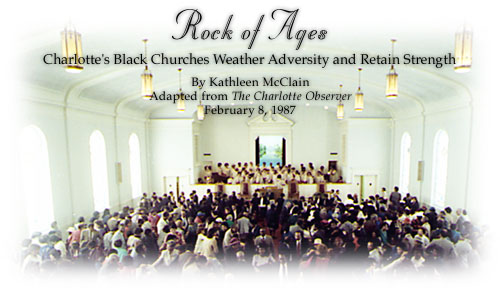
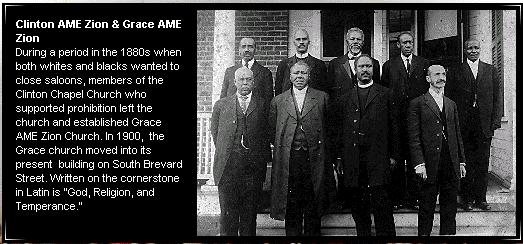
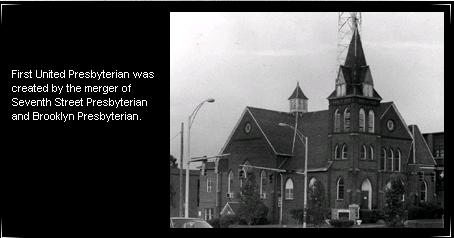

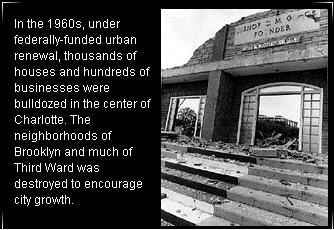
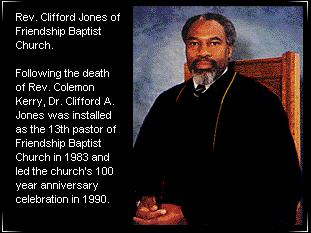
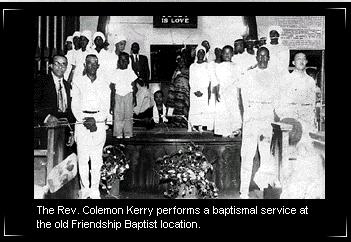
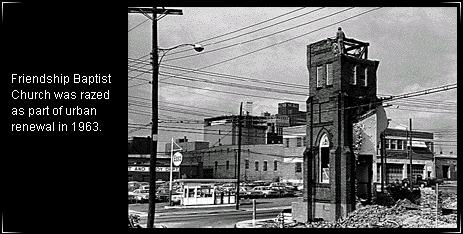
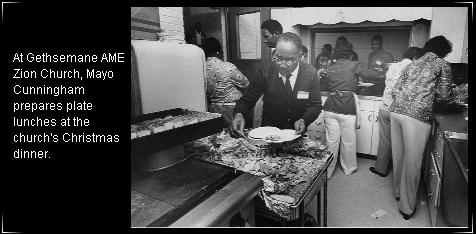
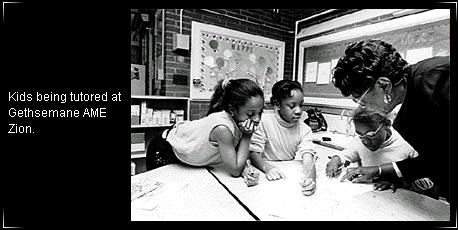
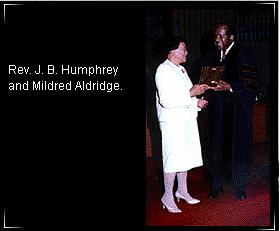
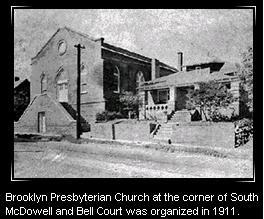
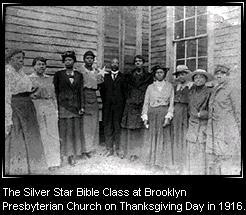
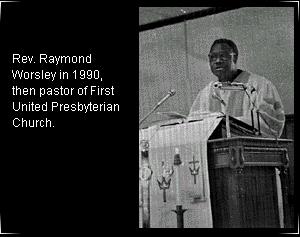
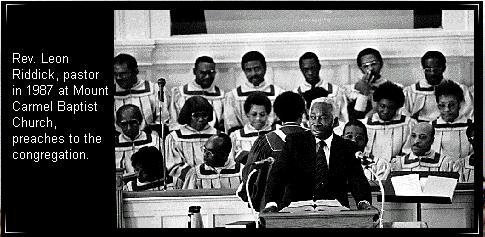
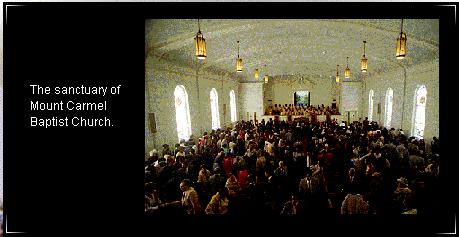
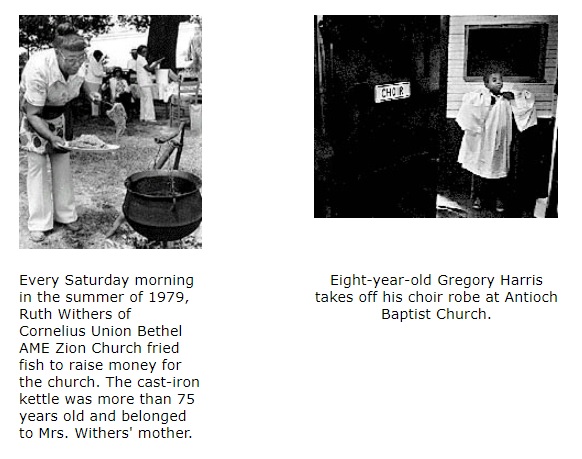
The African American Album: The Black Experience in Charlotte and Mecklenburg County. Vol. 2. Charlotte, NC: Public Library of Charlotte and Mecklenburg County, 1998. Computer optical disc, 4 3/4 in.